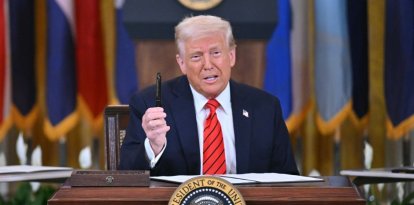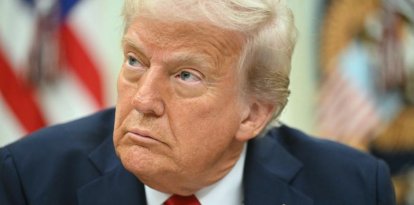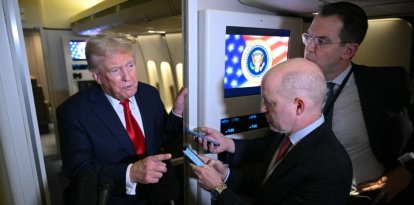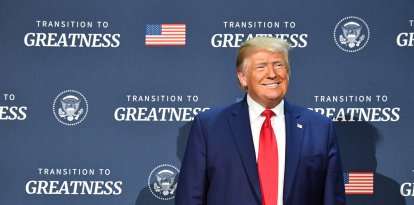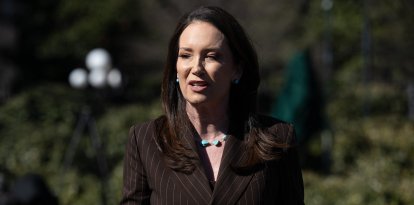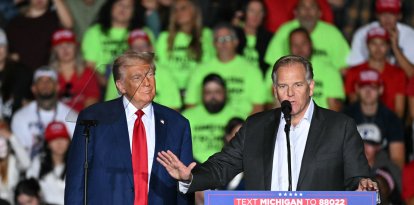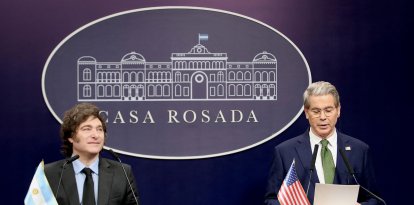Trump opts for Johnson's proposal: a single giant bill to pass his agenda through Congress
The president publicly endorsed the House Republicans' choice over the Senate's, which favored splitting Trump's priorities into two separate pieces of legislation.
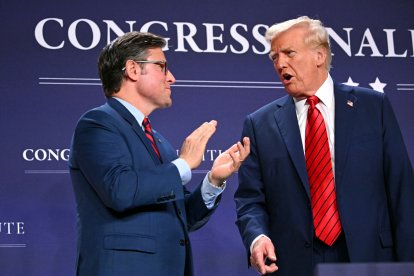
Mike Johnson and Donald Trump
A month after returning to the White House, Donald Trump chose how to pass his legislative agenda through Congress. After a lot of meditation and hours of discussion with Republicans in both chambers, the president chose Mike Johnson's proposal and will push a single giant bill with all of his priorities inside. In Trump's words, a "big, beautiful bill."
The House speaker beat out John Thune (R-SD), Republican majority leader in the Senate, who championed the idea of splitting the president's agenda into two separate pieces of legislation. Lindsey Graham (R-SC) and Ted Cruz (R-TX) attempted to convince the president that this proposal was simpler to pass through Congress, but Trump ultimately went with Johnson's.
Trump therefore decided that he will advance energy, border and tax reforms in a single bill. He communicated his decision on his Truth Social account, where he encouraged Senate and House Republicans to work together to condense everything into a single text. He will do so through Budget Reconciliation, a sort of legislative shortcut that sidesteps the Senate's filibuster rule and passes certain legislation without having the 60 votes needed in the Senate.
">( @realDonaldTrump - Truth Social Post )
— Donald J. Trump 🇺🇸 TRUTH POSTS (@TruthTrumpPosts) February 19, 2025
( Donald J. Trump - Feb 19, 2025, 9:26 AM ET )
The House and Senate are doing a SPECTACULAR job of working together as one unified, and unbeatable, TEAM, however, unlike the Lindsey Graham version of the very important Legislation… pic.twitter.com/v5etrY7w0h
"The House and Senate are doing a SPECTACULAR job of working together as one unified, and unbeatable, TEAM, however, unlike the Lindsey Graham version of the very important Legislation currently being discussed, the House Resolution implements my FULL America First Agenda, EVERYTHING, not just parts of it!" the President wrote.
"We need both Chambers to pass the House Budget to 'kickstart' the Reconciliation process, and move all of our priorities to the concept of, 'ONE BIG BEAUTIFUL BILL'. It will, without question, MAKE AMERICA GREAT AGAIN!" he added.
"I didn't see it coming"
John Thune expressed surprise at the president's decision to stick with the House proposal. "I didn't see it coming," he told reporters present on Capitol Hill.
"I think we’re all heading in the same direction. We all want to get to the same result and ultimate destination. How we get there is still a point of discussion. It’d be really boring if we had a unicameral system, wouldn’t it?" added the Republican leader, who met Wednesday with JD Vance to discuss the issue.

Politics
Learn all about the legislative shortcut that could make Trump's life easier in Congress
Joaquín Núñez

Politics
Trump rips into McConnell for voting against RFK Jr. : 'He’s not equipped mentally'
Joaquín Núñez
The Senate still plans to move forward with its plan of two different pieces of legislation
Following the meeting Senate Republican leaders held with Vice President Vance, Thune clarified that they will move forward with their plan.
"The House, as you know, is working on a different budget resolution, and we certainly wish them all the success in moving it. We will work closely with them. More power to them," the South Dakota Republican noted.
Sen. Graham was a bit more dissatisfied with the House's one-bill proposal, although he did not rule out supporting it in the future.
"I’m pulling for the House to pull it together and get one big, beautiful bill, but it’s got to be consistent with President Trump’s tax agenda," Graham said, adding that Johnson's current bill does not include the fiscal agenda.
">The House and the Senate want the same outcome: to quickly pass @POTUS’ full agenda.
— Leader John Thune (@LeaderJohnThune) February 19, 2025
That is why the Senate is here working and moving forward on Chairman @LindseyGrahamSC’s budget resolution that will preserve optionality and unlock the process to provide the necessary… pic.twitter.com/5exMnnnTsu
What is Budget Reconciliation?
This process was created out of the Congressional Budget Act of 1974 and has since been used 27 times, 23 of which ended successfully for the president in office with the legislation in question enacted.
Broadly speaking, it allows bills to move forward by circumventing the Senate's filibuster rule.
Under the Byrd Rule, named for Senator Robert Byrd of West Virginia, it can only be used on legislation that directly affects the budget on these issues:
- Increases or decreases the spending of the Federal Government.
- Increases or decreases the revenue of the Federal Government
- Modifies the public debt limit
Issues outside this framework cannot be included in Budget Reconciliation.
In terms of how it works, the House and Senate committees responsible for the affected areas (e.g., Finance or Commerce) draft the necessary changes as directed. They then send their proposals to the Budget Committee of each chamber, which combines them into a single reconciliation bill for debate sooner rather than later.
In turn, its content is dealt with in stages. In a process known as "Vote-a-rama," senators can propose amendments and vote on them without limit before the final vote on the entire bill.
How many times per year can it be used?
"In practice, however, a tax bill is likely to affect not only revenues but also outlays to some extent (for example, via refundable tax credits). Thus, as a practical matter a single budget resolution can probably generate only two reconciliation bills: a tax-and-spending bill or a spending-only bill and, if desired, a separate debt limit bill," the Center on Budget and Policy Priorities explained.
RECOMMENDATION
